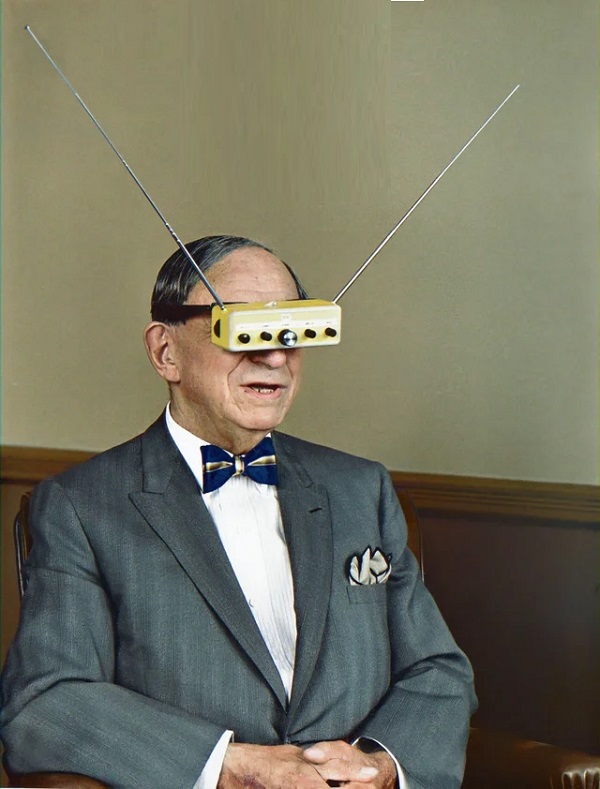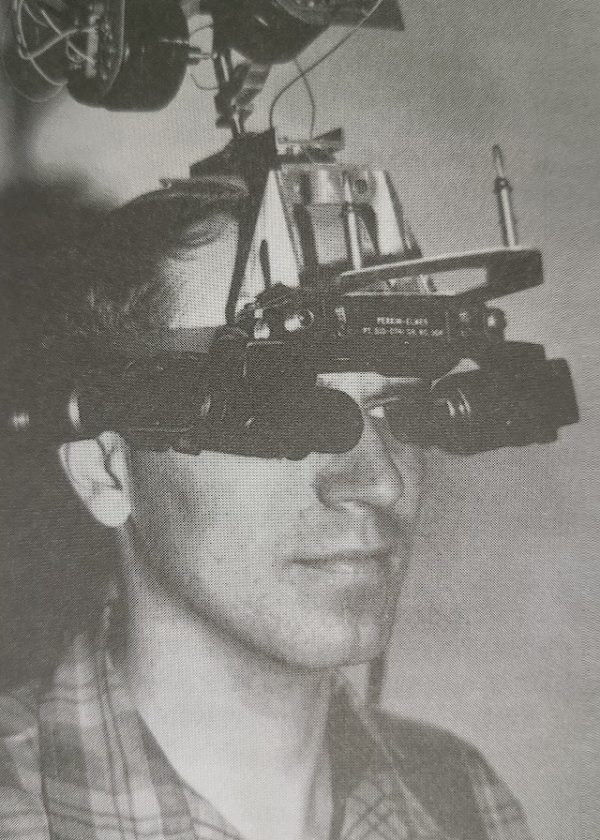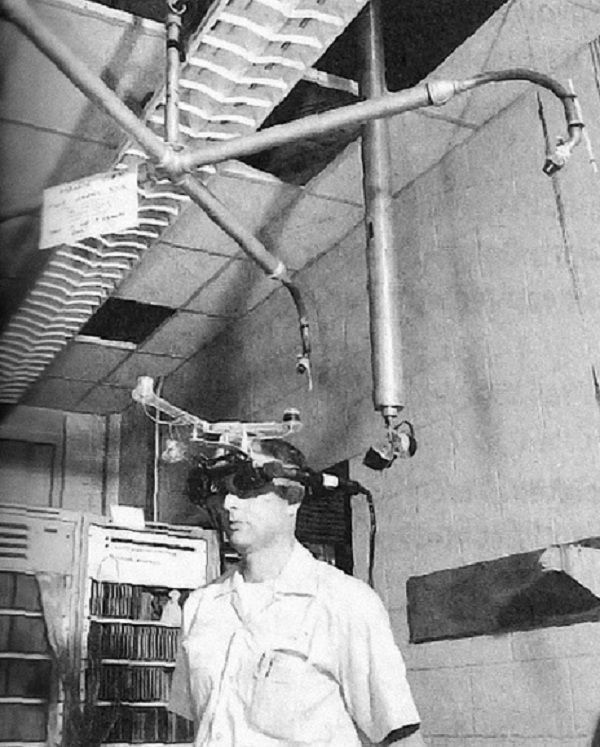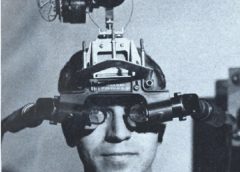As Morton Heilig struggled to convince a reluctant entertainment business to back his ideas, the first minicomputer based on transistors rather than tubes became available in 1960. The Digital Equipment Corporation’s (DEC) PDP-1 was the harbinger of the technology that would, more than 25 years later, succeed at popularizing virtual experiences where Sensorama failed.

The PDP-1 represented a revolution in computer affordability and performance based on the new silicon technology, computers began spreading out to universities and research institutes across America. But interacting with these early computers was difficult because they weren’t designed from a users point of view. Card-punch and batch processing required the user to adapt to the computer instead of the other way around.
Time sharing and interactive video screens didn’t exist in 1960 and it would be almost twenty years before the first personal computer would appear. Using one of these early computers was a frustrating experience—there had to be a better way.
In the early 1950s, an engineer in Mountain View, California, Douglas Engelbart, decided to figure out a way to tum computers into a powerful problem-solving tool that anyone could use, With a background in working with radar systems for the Navy, Engelbart realized that video screens could be used instead of paper to display the computer’s output.
His next breakthrough was realizing that they could also be used to control the computer, to provide it with input. This was a revolutionary idea, given that both video screens and computers were relatively rare and inaccessible.
Engelbart spent the next several years organizing his thoughts and trying to gain access to the few computers available at the time. While working at SRI in Menlo Park in the mid-1960s, the Advanced Research Projects Agency (ARPA, the forerunner to DARPA and sponsored by the US Defense Department) provided funding for Engelbart to pursue his ideas.
He finally had the financial resources to build the mind augmentation devices he had been dreaming of for the last decade, His lab, the Augmentation Research Center (ARC) was responsible for some of the key computer-human interface developments that we still use today.
In 1968, he gave an amazing demonstration at the Fall Joint Computer Conference. Using a crude pointing device (the first mouse), he selected a document to read from an iconic representation on a video display. This opened up and displayed the contents of the document on the screen. Still using the mouse, he cut and pasted a section of text elsewhere in the document. Remember, almost everyone used punched cards to talk to computers at the time. This was a radically new way to use computers and it changes PC’s forever.
Not only did Engelbart invent word processing, but he also demonstrated the rudiments of a hypertext environment. This was a real breakthrough—now people could interact with computers in a more direct and natural way. While Cinerama and Sensorama struggled to break down barriers in the film experience, Engelbart was breaking down the same barriers with computers.
The Ultimate Display
Back on the East coast, Ivan Sutherland was also busy changing the way people interacted with computers. He realized the enormous importance of getting computers to conform to the way people worked and thought, instead of the people conforming to computers. Credited with being the “father of computer graphics” by the industry he helped found, he pioneered many of the basic methods of using computers to represent 2-D and 3-D images.
His Sketchpad program in 1962 demonstrated the use of a light pen to draw images on a computer screen and was the precursor to the multi-billion dollar computer-aided design (CAD) industry of today. In 1965, Sutherland published an article entitled ‘The Ultimate Display‘ in which he described the following…
“We live in a physical world whose properties we have come to know well through long familiarity. We sense an involvement with this physical world which gives us the ability to predict its properties well. For example, we can predict where objects will fall, how well-known shapes look from other angles, and how much force is required to push objects against friction. We lack corresponding familiarity with the forces on charged particles, forces in non-uniform fields, the effects of non-projective geometric transformations, and high-inertia, low-friction motion. A display connected to a digital computer gives us a chance to gain familiarity with concepts not realizable in the physical world. It is a looking glass into a mathematical” – Ivan Sutherland, 1965

The Viral Fake
In 1963 a Luxembourgish–American inventor called Hugo Gernsback is said to have created the first entertainment eyewear device that he called his “television goggles”. This pocket-sized, battery-operated portable TV had a separate screen for each eye much as most modern VR headsets do. The device provided an experience Life Magazine described as “neo-Martian.” At only about 140 grams (a little less than a third of a pound), the glasses came with small cathode-ray tubes inside of them, a pair of antennae protruding from their top (like those found on old TVs), and a promise from Gernsback that they posed no risk of electrocution…anymore. He also invented lunar mining, orbital mirror arrays and the teleportation of ham sandwiches! With those other inventions in mind you don’t need me to tell you that these “television goggles” were in fact fake, indeed all of his inventions left the actual mechanics of things for others to invent. He was just an ideas man. Getting back to things that were a little more real would take a few more years…
The Sword of Damocles
Another example of Sutherland’s creativity was the development of the first Sainputer-based head-mounted display (HMD) in 1966 at the MIT Lincoln Laboratory and later at the University of Utah. He had to invent from scratch most of the technology that twenty years later NASA would use to assemble the first of what we consider these days to be a modern VR environment.

Sutherland’s head-mounted display earned the nickname ‘the sword of Damocles‘ due to the mass of hardware that was supported from the ceiling above the user’s head. The reason for this is that the weight of the HMD was too much to bear without some additional support. A mechanical apparatus determined where the viewer was looking and monoscopic wire-frame images were generated using two small Cathode-ray tubes (CRTs) mounted alongside each ear.

Optics focused the image onto half-silvered mirrors placed directly in front of the eves. The mirrors allowed the computer-generated images to overlay the view of the world (in contrast, most of today’s VR systems obscure the view of the outside world). Users of the system viewed a wire-frame cube floating in space in the middle of the lab. By moving their head around they could see different aspects of the glowing cube and determine its size and placement.
When Sutherland joined the University of Utah, he continued to refine the hardware and software until, in 1970, the first fully functional HMD was completed. His final system consisted of several hardware accelerators to improve the performance of the graphics system and the generation of stereoscopic images instead of monoscopic.
In general terms, there’s no difference between this system and the system that was to emerge from NASA Ames almost twenty years later. The long search for a synthesized reality had finally led to a system capable of generating virtual objects. Finally, the visions of Sutherland and Engelbart were realized. The barrier between the computer and the user had finally been eliminated; the user was now inside the computer.
Then, during World War II everything changed for VR technology because virtual training was about to become a real thing.


